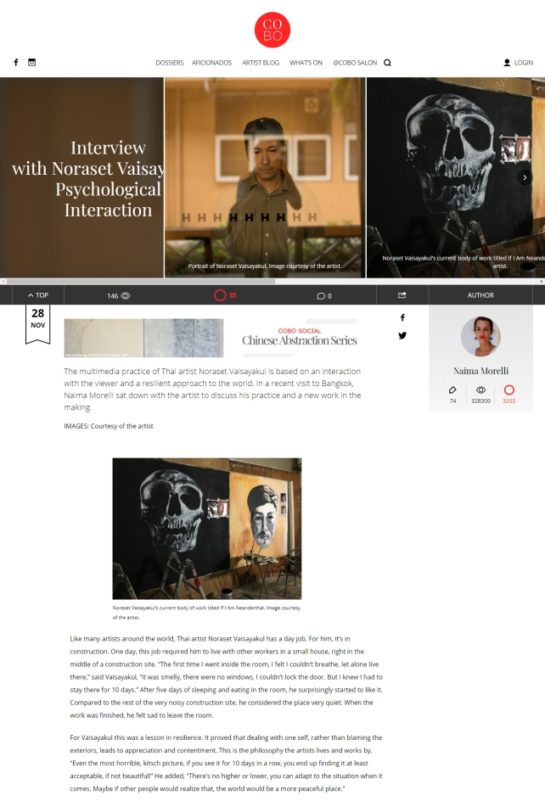
At the beginning of the year I have realized a reportage on Thai contemporary art. The webmagazine CoBo Social has just published my interview with artist Noraset Vaisayakul.
Here is the link to the interview
Read More
Lim Tzay-Chuen’s elliptical approach
It’s a matter of fact that when a concept is so deeply embedded in a society, often artists tackle it not as a separate topic, but in its many manifestations. As Tan Boon Hui Calvin, Vice President, Global Arts & Cultural Programs and Director, Asia Society Museum, NY, à Asia Society, puts it : “The best work engaging with the concept of bureaucracy is the elliptical in approach. I honestly do not think it will be as blunt as ‘bureaucracy’.” One example of this elliptical approach is the work of Lim Tzay Chuen.
The artist describes his work as being concerned with “offering” solutions to possible problems, becoming about administration and organisation – aspects that are an integral part of the art world, but are usually left out from the official narrative. For the Biennale of Sydney, he designed and coordinated an open proposition to the public: “Enterprising” persons who got hold of certain pages from the 2004 Biennale catalogues would enjoy the privilege of using the Artspace Gallery 1, AUD $4000, 4 nights of hotel accommodation and official inclusion as one of the invited “artists” to the Biennale.
Read More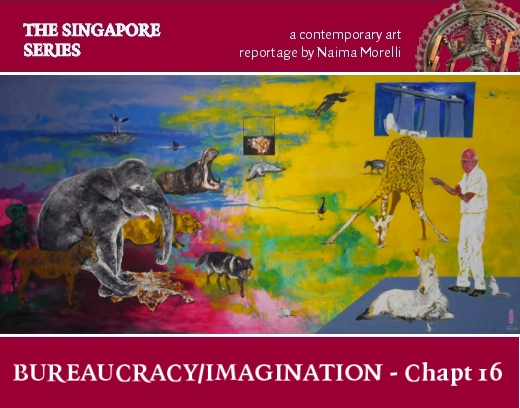
Take a guess: what is the opposite of artwork? It is paperwork. Whereas the artwork is open-ended, a spreadsheet is self-contained. In other words, the artwork is an object that dispels the notion of identity of objects; a notion which nonetheless is so useful for us to go around the world. We think about a bottle based on its function of containing and pouring liquid. But try to go to Swanston Street, Melbourne on Saturday night, and you’ll see how that a bottle can become a dangerous weapon. For the same reason, we are always very careful to not let kids pick up objects that are potentially dangerous, because children are oblivious to the categories that us adults create for objects and things.
While living outside the categories in everyday life is potentially dangerous – you’d be called a crazy person – the blurring and crossing over of categories is what allows creativity and imagination to happen. Kids are imaginative because they are ultimately approaching things as they are. Infinite. The truth is that things do offer themselves to ambiguity. Contemporary art is particularly apt to prove that.
While ambiguity is inherent in all objects within our reality, we have countless examples of artists that emphasize that notion in their work. To remain in contemporary Southeast Asia, think about Indonesian artist Wiyoga Muhardanto, whose entire process consists of combining two contrasting meanings – for example merging an Apple computer design to an old typewriter, or fusing a fashionable bag with old saggy skin – thus opening up multiple interpretations for the object. We have of course other examples in the milestones of art history, such as Duchamps’ upside-down urinal or Magritte’s “Ceci n’est pas une pipe”. Not by chance, Magritte was part of the surrealist movement, which was all about playing around with objects, subverting their meaning. Surrealists were also very keen on studying dreams – that door to our psyche where things happen outside of logic and the rational realm. In that world, the categories crumble. Our way of thinking about things by free association becomes the reality that happens before our eyes, which is a form of truth – as often madness is.
Read More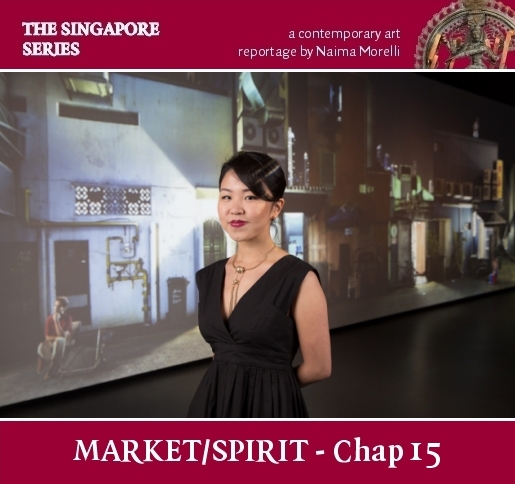
Sarah Choo Jing
I love the work of Sarah Choo Jing. It is elegant and she clearly shares a passion for my favourite director, Hong Kar Wai. The artist herself gives me the impression of living in her own imaginary, which is something I can highly empathise with. At the 2017 Venice Biennale show, she was elegant as ever, wearing a blue cheongsam with a pair of silver shoes which looked as if they were right from Grace Kelly’s wardrobe. Her attire made her look like a noble Chinese woman on a visit to the West. Being in Venice, another celebrated city port, this looked like the possible start of a story.
When I interviewed her in Singapore at the end of 2015, she carved out a time to meet me amid the shots of the production of her new video piece called “Four Days”, set in a prestigious hotel near Chinatown. Actually, it was unclear to me if it was the lack of time to dictate the conditions for this meeting, or if it was rather a wise choice to allow me to participate in the production process and get some juice for the story. At one point the artist admitted that the circumstances were quite fortuitous.
Read More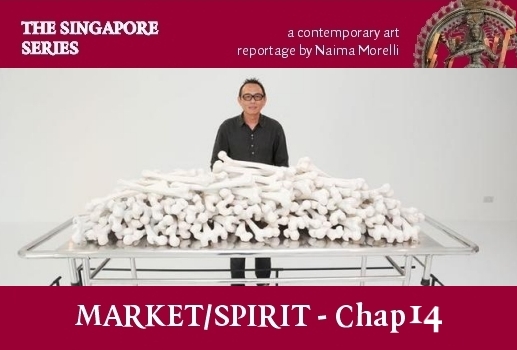
Vincent Leow
It is June 2018 as I’m writing these lines, and a few days ago, browsing through the internet, some news hit my eye. One drawing of Vincent Leow was removed from an exhibition the Esplanade, a popular alley for the arts in Singapore, with the accusation of “bestiality”. The censored sketch depicted a naked individual sitting astride a giant chicken. According to the conservative Facebook group “Singaporeans Defending Marriage and Family” the naked man was having sex with the animal. The general concern revolves around the fact that this was public area, with kids walking past the exhibition to go to the play centre. At first, the Esplanade took a neutral stance and said that everyone could “draw their own interpretations of a drawing that is not a realistic rendering.” Following a discussion with the artist, the art centre decided that it would be best to remove the piece from the exhibition and said that “This is solely Esplanade’s error of judgment”. This caused a big buzz in the artistic community in Singapore, and was seen as an episode of censorship and a sign of an increasingly conservative society.
The author of the sketch, Vincent Leow, would probably be discouraged to see that, since he first started with his provocative works and the society hasn’t opened up since. Quite the contrary. Vincent hailed, like Lee Wen and Amanda Heng, from The Artists Village, the arts collective spearheaded by Tang Da Wu and inspired by Western movements such as conceptual art and Fluxus, which emerged in New York in the ‘60s. The group detached from the idealist watercolours and academic realist style that preceded the late ‘80s, as being really contemporary and bringing international tendencies to the art world, while speaking of the conflicts and tensions of the society at the time.

Amanda Heng
Taking a sip of tea in the courtyard sheltered by the white colonial walls of the Singapore Art Museum, I had no doubt. When I get older, I want to be cool like Amanda Heng. This double-braided lady sitting on the other end of the table is an inspiring and yet down-to-earth artist. Despite her friendly nature, she gave a huge contribution to the evolution of Singaporean contemporary art. In the Lion City, economic and technological progress are achieved thanks to a pragmatic government and toiling on the part of citizens. Amanda Heng witnessed the rapid transformation in both the art scene and the society art at large. Her work is a profound comment on this rapid modernisation and a compassionate observation about those who were left behind.
Amanda Heng was one of the early members of the seminal art collective ‘The Artist Village’ and experimented with performance art and installation. When she was a little girl in school, she was always performing on stage. In the school curriculum there were dances, songs, opera, and they were learning Italian songs. “I guess I already had this in me, and it allowed me to feel the beauty of certain things, although I didn’t know what art was about then.”
Read More
Audience anxiety
In 2017, I visited a show a of ceramic artist Iskandar Jalil, in dialogue with the young Singaporean artist Gerald Leow at the National Gallery of Singapore. Gerald’s day job was set design, and it showed from his intervention in the show, which was very subtle. He built a metal structure evoking the traditional house of Inskandar with a simple metal outline. I was looking forward to seeing the show since the artist mentioned that he was doing research from it in our first interview, and I peered out curiously into the room. Before I had the chance to set foot inside, the gallery sitter, gentle as ever, handed me a flyer: “Please find here some information about the show. You will find also the interview of the curator with Gerald Leow and some information about the content of the show. Please proceed to your left to see the exhibition.” Being a Neapolitan, so a rule-breaker by nature, I was about to blurt out: “Well, what if I want to start from the right?” After all, there was no chronology intended in the work, and there were no other people in room. But instead, I shut up and remembered where I was. And yes, I was in a place where the so-called audience anxiety was real.
Read More
The norm and the individual
My curator friend Roberto D’Onorio and I have very different tastes when it comes to historical figures. I have always been all about the bat shit crazy personalities such as Caligula – which obviously attracted me for their romanticism, their “freedom in their own psychosis”. Conversely, Roberto has always been all about the composed, formal figures, among which his favourite is the Queen Elizabeth II.
He doesn’t just like her. He’s crazy about her to the point that he watched all the documentaries about her, all the series and of course the movie “The Queen”. What he likes about her is that she, unlike her other contemporaries such as Churchill or Margaret Thatcher – who by the way was referred to as having the lips of Marylin Monroe and the eyes of Caligula – was a sane individual in a system which required her to be there.
She didn’t have to make any kind of choice, she just had to follow a protocol which was already laid out for her. She just needed to embody it in the best way possible, and adapt her personality to it. As Roberto pointed out, Elizabeth was a sane individual operating in a system that catered to her. The system itself was something that had no reason to exist other than to keep power structures in place. And that brings us to talk about Singapore and its artists.

Ho Tzu Nyen: representing the global collective imaginary
There are artists who make objects, and are pretty damn good at their craft. Then there are artists whose production allow them to live and work in the art system. There are also artists whose work is autobiographical and very much tied to their lives. And finally, there are artists whose art is a direct continuation of their philosophical grasp on the world. Technique for them is an extension of their thought.
Singaporean artist Ho Tzu Nyen belongs to the latter category. In his first solo exhibition in Berlin at the gallery Michael Janssen called “No Man II”, he presented a new multimedia installation. This whimsical, interactive, compelling, yet mysterious work looks like a museum of popular imagination of the human figure. We can find here clichéd representation from pop culture, from American soldiers, to characters similar to the movie Tron, all the way to mythology.
Read More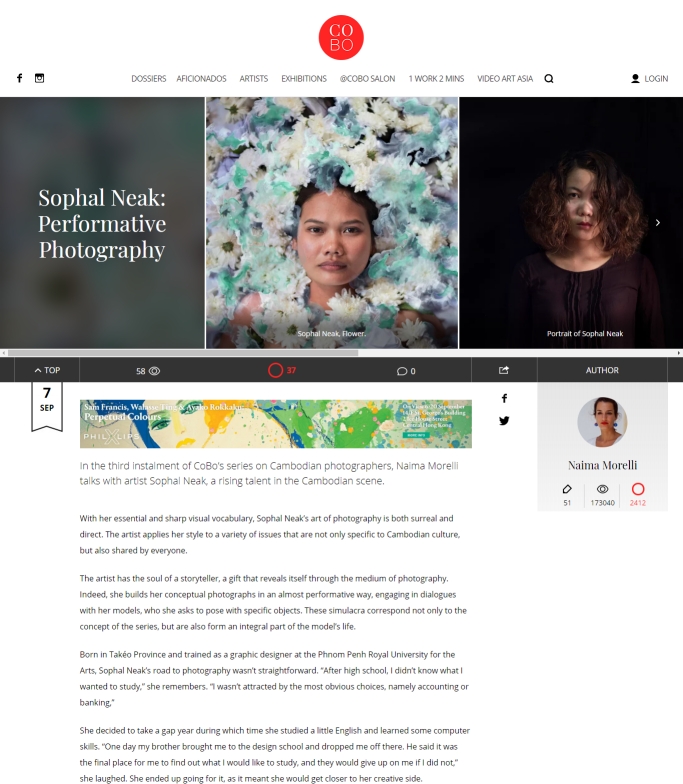
In the third installment of CoBo’s series on Cambodian photographers, I spoke with artist Sophal Neak, a rising talent in the Cambodian scene. This piece is part of my reportage on Cambodian contemporary art.
Here is the link to the interview
Read MoreMy interview with the wonderful Singaporean artist Amanda Heng has just been published on the new webmagazine D_Railed.
Amanda Heng’s work has been seminal in the development of Singaporean contemporary art and resonate with art viewers from all walks of life. Along with her production she greatly contributed to the growth of the Southeast Asian scene and the cultural discourse in the region by setting up initiatives and groups.
Interviewing Amanda Heng was a blast. She is a strong, inspiring figure and yet gentle and friendly. In the original hour and a half long recording of the interview we talk about many different topics. In this piece though I have decided to focus mainly on her perspective on Singaporean culture and the local art scene. I thought this was the best solution for someone who isn’t familiar with the context in which the artist operates.
The interview is part of my reportage on Singapore contemporary art, and part of the foundation for a book on the same topic I’m currently working on.
A few words on the magazine; D_Railed has been just founded by colleague and friend Deianira Tolema, a talented writer working between New York and Naples. I greatly admire her determination in realizing everything she put her mind to do and I’m honoured to be part of her team from the start!
Read More
Welcome to another installment of my series on artist studio visits. This time we are peeking into the working space of Singapore artist Robert Zhao Renhui at Goodman Arts Centre. In the course of my reportage in Singapore I became familiar with this studio cluster, as many of the most prominent local artists are operating from here.
I find Robert’s studio pretty amazing. It is filled with the most strange objects and books related to science, biology and animals – included cushions shaped like kittens. If you are familiar with Robert Zhao artist practice, you will know he operates under the name of the fictional The Institute of Critical Zoologist. His work is all about developing a critical approach to the zoological gaze. This involves playing around with the believes of the viewer and acceptance of truths. Robert’s recent projects consider the increasingly ill-defined boundaries between the natural and the man-made.
Robert’s studio shows that zoology for the artist is not merely the subject of his work, but a real obsession. He demonstrates the theory of my friend curator Donato: “At the end of the day artist are people with single-minded obsession.”
Read More